 Haridwar is the gateway to the four pilgrimages (Char Dham Yatra)
of Uttarakhand. Haridwar is an important pilgrimage city and municipality
in the Haridwar district of Uttarakhand, India. The River Ganges, after
flowing for 253 kilometres (157 miles) from its source at Gaumukh at the
edge of the Gangotri Glacier, enters the Indo-Gangetic Plains of North India
for the first time at Haridwar, which gave the city its ancient name, Gangadwára.
Haridwar is the gateway to the four pilgrimages (Char Dham Yatra)
of Uttarakhand. Haridwar is an important pilgrimage city and municipality
in the Haridwar district of Uttarakhand, India. The River Ganges, after
flowing for 253 kilometres (157 miles) from its source at Gaumukh at the
edge of the Gangotri Glacier, enters the Indo-Gangetic Plains of North India
for the first time at Haridwar, which gave the city its ancient name, Gangadwára.
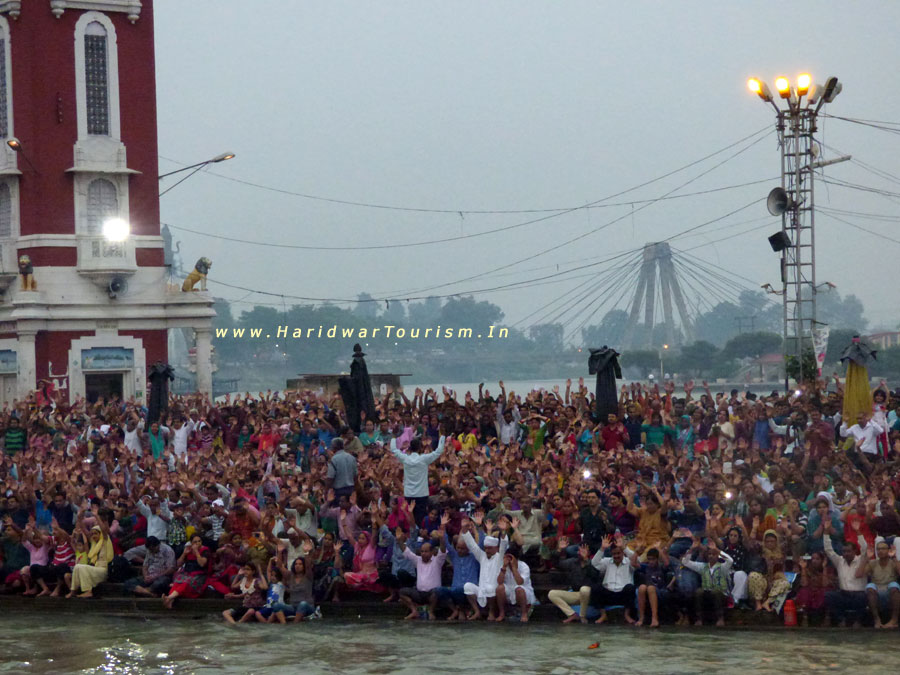
Haridwar is also the starting point on the journey to the sacred sources
of the rivers Ganga and the Yamuna. According to legend, Prince Bhagirath
performed penance here to salvage the souls of his ancestors who had perished
due to sage Kapil’s curse. The penance was answered and the river Ganga
trickled forth from Lord Shiva's locks and its bountiful water revived the
sons of King Sagara. In the tradition of Bhagirath, devout Hindus stand
in the sacred waters here, praying for salvation of their ancestors.
Maa Ganga Aarti - Har Ki Pauri - Har Har Gange
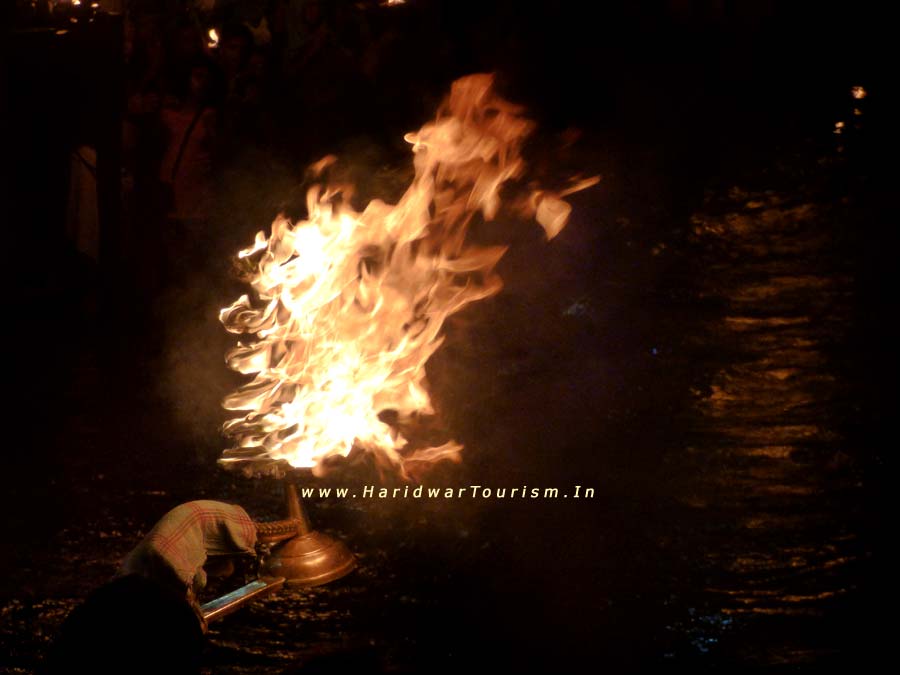
Haridwar is regarded as one of the seven holiest places to Hindus. According
to the Samudra manthan, Haridwar along with Ujjain, Nasik and Allahabad
is one of four sites where drops of Amrit, the elixir of immortality, accidentally
spilled over from the pitcher while being carried by the celestial bird
Garuda. This is manifested in the Kumbha Mela being celebrated every 3 years
in one of the 4 places, and thus every 12 years in Haridwar. Amidst
the Kumbha Mela, millions of pilgrims, devotees, and tourists congregate
in Haridwar to perform ritualistic bathing on the banks of the river Ganges
to wash away their sins to attain Moksha. Brahma Kund, the spot where the
Amrit fell, is located at Har ki Pauri (literally, "footsteps of the Lord")
and is considered to be the most sacred ghat of Haridwar.
Haridwar is the headquarters and the largest city of the district. Today,
the city is developing beyond its religious importance, with the fast developing
industrial estate of State Infrastructure and Industrial Development Corporation
(SIDCUL), and the close by township of Bharat Heavy Electricals Limited
in Ranipur, Uttarakhand as well as its affiliated ancillaries.
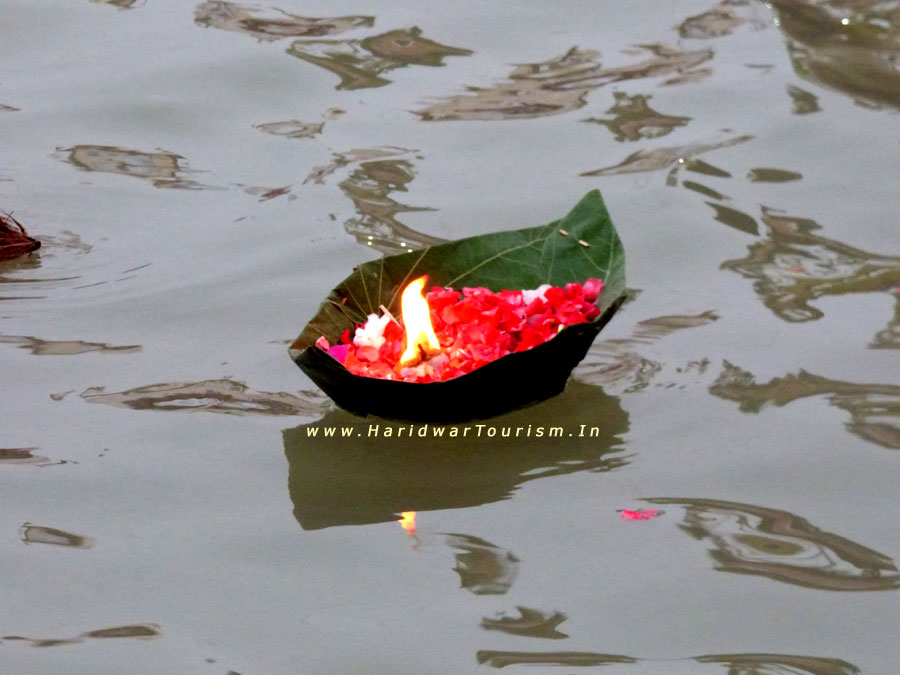
 Etymology
Etymology
In Sanskrit, Haridwar stands for Dwara of Hari or Gateway to God, where
'Hari' means God and 'dwar' means gate. In ancient times, the city was referred
to as Gangadwára, the place where the Ganges descends to the plains
 History of Haridwar
History of Haridwar
A paradise for nature lovers, Haridwar presents a kaleidoscope of Indian
culture and civilization. In the scriptures it has been variously mentioned
as Kapilsthan, Gangadwar and Mayapuri. It is also an entry point to the
Char Dham (the four main centers of pilgrimage in Uttarakhand viz, Badrinath,
Kedarnath, Gangotri, and Yamunotri), hence, Shaivaites (followers of Lord
Shiva) and Vaishnavites (followers of Lord Vishnu) call this place Hardwar
and Haridwar respectively, corresponding to Har being Shiv and Hari being
Vishnu.
The legendary King, Bhagirath, the great-grandson of the Suryavanshi King
Sagar (an ancestor of Rama), is said to have brought the river Ganges down
from heaven, through years of penance in Satya Yuga, for the salvation of
60,000 of his ancestors from the curse of the saint Kapila, a tradition
continued by thousands of devout Hindus, who brings the ashes of their departed
family members, in hope of their salvation. Lord Vishnu is said to have
left his footprint on the stone that is set in the upper wall of Har-Ki-Pauri,
where the Holy Ganges touches it at all times.
Haridwar came under the rule of the Maurya Empire (322–185 BCE), and later
under the Kushan Empire (c. 1st–3rd centuries). Archaeological findings
have proved that terra cotta culture dating between 1700 BCE and 1200 BCE
existed in this region. First modern era written evidence of Haridwar is
found in the accounts of a Chinese traveller, Huan Tsang, who visited India
in 629 AD. during the reign of King Harshavardhan (590–647) records Haridwar
as 'Mo-yu-lo', the remains of which still exist at Mayapur, a little to
the south of the modern town. Among the ruins are a fort and three temples,
decorated with broken stone sculptures, he also mentions the presence of
a temple, north of Mo-yu-lo called 'Gangadwara', Gateway of the Ganges.
 Geography of Haridwar
Geography of Haridwar
The Ganges emerges from the mountains to touch the plains. The water in
the river Ganges is mostly clear and generally cold, except in the rainy
season, during which soil from the upper regions flows down into it. The
river Ganges flows in a series of channels separated from each other called
aits, most of which are well wooded. Other minor seasonal streams are Ranipur
Rao, Pathri Rao, Rawii Rao, Harnaui Rao, Begam Nadi etc. A large part of
the district is forested, and Rajaji National Park is within the bounds
of the district, making it an ideal destination for wildlife and adventure
lovers. Rajaji is accessible through different gates; the Ramgarh Gate and
Mohand Gate are within 25 km of Dehradun, while the Motichur, Ranipur and
Chilla Gates are just about 9 km from Haridwar. Kunao Gate is 6 km from
Rishikesh, and Laldhang gate is 25 km from Kotdwara. Haridwar district,
covering an area of about 2360 km², is in the southwestern part of Uttarakhand
state of India. Haridwar is situated at height of 314 metres from the sea
level, between Shivalik Hills in the North and Northeast and the Ganges
River in the South.
 Best time to Visit Haridwar :-
Best time to Visit Haridwar :-
Haridwar is a picturesque destination affording enchanting views throughout
the year.
The right time to visit would be February, March, August-October. In July
there is a festival called Savan where thousands of people
flock to Haridwar. Major roads are blocked and hotels are crowded. It
is better to avoid travelling to Haridwar during that time.
 Pilgrimage in Haridwar :-
Pilgrimage in Haridwar :-
Har Ki Pauri
This sacred Ghat was constructed by King Vikramaditya (1st century BC)
in memory of his brother Bhrithari. It is believed that Bhrithari came
to Haridwar and meditated on the banks of the holy Ganges. When he died,
his brother constructed a Ghat in his name, which later came to be known
as Har-Ki-Pauri. The most sacred ghat within Har-ki-Pauri is Brahmakund.
The evening prayer(Aarti) at dusk offered to Goddess Ganga at Har-Ki-Pauri
(steps of God Hara or Shiva) is an enchanting experience for any visitor.
A spectacle of sound and colour is seen when, after the ceremony, pilgrims
float diyas (floral floats with lamps) and incense on the river, commemorating
their deceased ancestors. Thousands of people from all round the world
do make a point to attend this prayer on their visit to Haridwar. A majority
of present ghats were largely developed in the 1800s.
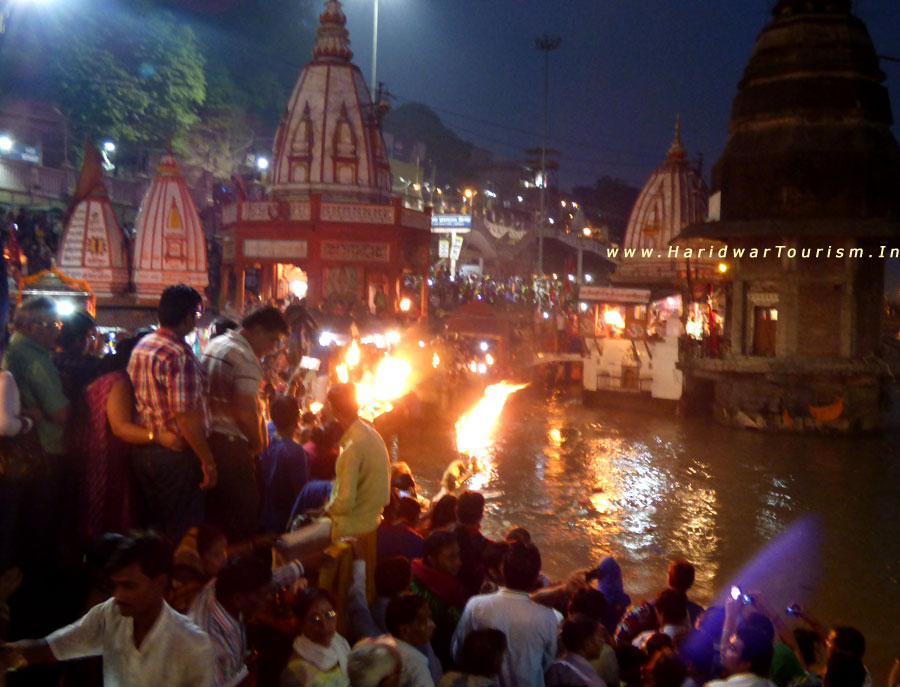
Chandi Devi Temple
Chandi Devi Temple, Haridwar The temple is dedicated to Goddess Chandi,
who sits atop the 'Neel Parvat' on the eastern bank of the river Ganges.
It was constructed in 1929 A.D. by the king of Kashmir, Suchat Singh.
Skanda Purana mentions a legend, in which Chanda-Munda, the Army Chief
of a local Demon Kings Shumbh and Nishumbha were killed by goddess Chandi
here, after which the place got the name Chandi Devi. It is believed that
the main statue was established by the Adi Shankracharya in 8th century
A.D. The temple is a 3 km trek from Chandighat and can also be reached
through a ropeway.
Mansa Devi Temple
Mansa Devi Temple, Haridwar Situated at the top of Bilwa Parwat, the temple
of Goddess Mansa Devi, literally meaning the Goddess who fulfills desires
(Mansa), is a popular tourist destination, especially because of the cable
cars, which offer a picturesque view of the entire city. The main temple
houses two idols of the Goddess, one with three mouths and five arms,
while the other one has eight arms.
Maya Devi Temple
Maya Devi Temple, Haridwar Dating to the 11th century, this ancient temple
of Maya Devi, the Adhisthatri deity of Hardwar, is considered one of the
Siddhapethas and is said to be the place where the heart and navel of
Goddess Sati had fallen. It is one of few ancient temples still standing
in Haridwar, along with Narayani Shila temple and Bhairav Temple.
Kankhal
Daksheswara Mahadev Temple The ancient temple of Daksha Mahadev also known
as Daksheswara Mahadev Temple, is situated in the south Kankhal town.
According to Hindu texts, King Daksha Prajapati, father of Dakshayani,
Lord Shiva's first wife, performed a yagna, to which he deliberately did
not invite Lord Shiva. When he arrived uninvited, he was further insulted
by the king, seeing which Sati felt infuriated and self-immolated herself
in the yagna kund. King Daksha was later killed by the demon Virabhadra,
born out of Shiva's anger. Later the king was brought to life and given
a goat's head by Shiva. Daksha Mahadev temple is a tribute to this legend.
Sati Kund, another well-known mythological heritage worth a visit is situated
in the Kankhal. Legend has it that Sati immolated herself in this kund.
Piran Kaliyar
Built by Ibrahim Lodhi, a ruler of Delhi, this 'Dargah' of Hazrat Alauddin
Sabir Kaliyari, a 13th century, Sufi Saint of Chishti Order (also known
as Sarkar Sabir Pak), in Kaliyar village, 7 km. from Roorkee, is a living
example of religious harmony in India, visited by devotees from all over
the world, during the annual 'Urs' festival, which is celebrated from
1 st day of sighting the moon to 16th day of Rabeeull month Islamic calendar.
Neel Dhara Pakshi Vihar
This Bird Sanctuary is situated on the main Ganges river, or Neel Dhara,
at the Bhimgoda barrage, it is a paradise for bird watchers and home to
many migratory birds during the winter season.
Bhimgoda Tank
This tank is situated at a distance of about 1 km from Har ki Pauri. It
is said that while Pandavas were going to Himalayas through Haridwar,
prince Bhima drew water from the rocks here by thrusting his knee (goda),
to the very ground.
Ram Mandir
This mandir is under construction near Saptarishi marge, at Bhupatwala.
Mandir is being constructed by Swami Ramanandacharya Smarak Seva Nyays
headed by Jagadguru Ramanandacharya Swami Ramnareshacharya of Sri math,
Panchganga Ghat, Varanasi. This Ram temple would be biggest in India.
Doodhadhari Barfani Temple
Part of the ashram of Doodhadhari Barfani Baba, this temple complex in
white marble is one of most beautiful temples in Haridwar, especially
the temples of Rama-Sita and Hanuman.
Sureshvari Devi Temple
Temple of Goddess Sureshwari, situated in midst of beautiful Rajaji National
Park. Serene and religious makes this temple abode of worshipers, saints
etc. Located at outskirts of Haridwar in Ranipur and permission from forest
rangers is necessary.
Pawan Dham
A modern temple, made entirely of glass pieces, and now a popular tourist
destination.The Temple complex was constructed by the effort of His Holiness
Swami Vedantanand Ji Maharaj and the Institiute is growing under the Leadership
of His Holiness Swami SahajPrakash Ji Maharaj. People of Moga ( Punjab)
has put their efforts and Money to bring up this place.
Bharat Mata Mandir
A multi-storey temple, dedicated to Bharat Mata, Mother India, with each
floor depicting an era in the Indian History, from the days of Ramayan
till India's independence. The temple was built under the auspicious blessings
of the honorable former Shankaracharya His Holiness Maha-Mandleshwar Swami
Satyamitranand Giriji Maharaj. Swami Satyamitranand Foundation was registered
in 1998. Since the inception of the Foundation, several other branches
have been opened, namely in Renukut, Jabalpur, Jodhpur, Indore and Ahmedabad.
The Bharat Mata Mandir was inaugurated on 15 May 1983 by Rt.Hon.Smt. Indira
Gandhi and stands along the River Ganges in Haridwar. It is situated adjacent
to the 'Smanvaya Ashram', and stands eight stories tall to the height
of 180 feet (55 m). Each floor is devoted to a particular theme. On the
first floor is the statue of Bharat Mata. The second floor ‘Shoor Mandir’
is dedicated to the well renowned heroes of India. The third floor ‘Matru
Mandir’ is dedicated to the achievements of India’s revered women; such
as Meera Bai, Savitri, Maitri etc. The great saints from various religions,
including Jainism, Sikhism and Buddhism are featured on the fourth floor
‘Sant Mandir’. The Assembly Hall with walls depicting symbolic coexistence
of all religions practiced in India and paintings portraying history and
beauty in various provinces of India, is situated on the fifth floor.
The various forms of the Goddess of Shakti can be seen on the sixth floor,
whilst the seventh floor is devoted to all incarnations of Lord Vishnu.
The eighth floor holds the shrine of Lord Shiva from which devotees can
gain a panoramic view of Himalayas, Haridwar, and the splendour of the
entire campus of Sapta Sarovar.
Jairam Ashram
Famous for its diorama exhibition, and a massive white statue depicting
the famous Samudra manthan episode, a must-see for any visitor.
Sapt Rishi Ashram and Sapt Sarovar
A picturesque place near Haridwar, where seven great sages or Saptarishis,
namely Kashyapa, Vashisht, Atri, Vishwamitra, Jamadagni, Bharadwaja and
Gautam, said to have meditated. The Ganges split herself into seven currents
at this place so that the Rishis would not be disturbed by the flow.
Parad Shivling
Situated in Harihar Ashram, Kankhal. Parad Shivling (Mercury Shivling)
weighing about 150 kg and Rudraksha tree are the main attractions here.
Ramanand Ashram
Situated in shravan nath nagar of the town near railway station, this
is the main ashram of Ramanand Sampraday in Haridwar. Mahant Bhagwan Das
is the chief of this ashram.
Anandamayi Maa Ashram
Situated in Kankhal, one of five sub-cities of Haridwar, the ashram houses
the samadhi shrine of Sri Anandamoyi Ma (1896–1982), a noted saint of
India.
Shantikunj
Shantikunj is the headquarter of famous spiritual and social organisation
All World Gayatri Pariwar (AWGP) established by Pt Shriram Sharma Acharya.
Its located at a distance of 6 Kilometers from Haridwar railway station
towards Rishikesh/Dehradun on NH58. At the bank of the holy Ganges and
between the Shivalik ranges of the Himalayas, its also a place of attraction
for tourists as well as seekers of spiritual guidance.
 Festivals in Haridwar :-
Festivals in Haridwar :-
Being a place of intense religious significance, Haridwar also hosts several
religious festivals throughout the year; popular among them are the Kavad
Mela, Somvati Amavasya Mela, Ganga Dashara, Gughal Mela, in which around
20-25 lacs (2-2.5 million) people take part. Apart from this, there is
the Kumbh Mela which takes place once in every twelve years, when the
planet Jupiter (Brihaspati) comes into the sign Aquarius (Kumbha). First
written evidence of the Kumbha Mela can be found in the accounts of Chinese
traveller, Huan Tsang or Xuanzang (602 - 664 A.D.) who visited India in
629 AD. According to The Imperial Gazetteer of India, an outbreak of cholera
occurred at the 1892 Mela at Haridwar, which lead to the rapid improvement
of mela arrangement by the authorities and the formation of 'Haridwar
Improvement Society', and in 1903 about 400,000 people attended the fair.
A stampede took place near Har-ki-Pauri, during the Kumbh Mela in 1980s,
in which 600 people were killed and scores injured. The 1998 Maha Kumbh
Mela saw over 80 million pilgrims visiting this city, to take a dip in
the holy river, the Ganges.
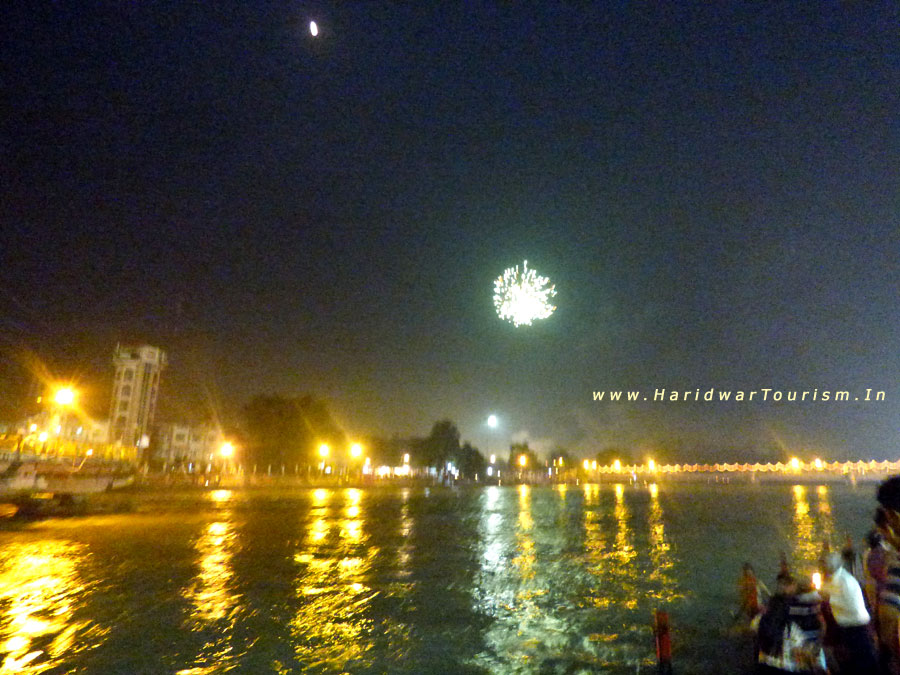
| |
FAIR,
FESTIVAL AND MAHOTSAV OF HARIDWAR
|
|
|
|
|
|
|
|
|
|
Haridwar
is one place where fairs are being organized with full enthusiasm
round the year, such as Somwati Amavasya, Kartik Poornima, Shravan
Poornima, Ganga Dussehra and other important bathing dates of Hindu
calendar. The Kanwad mela during the month of Shravana is very popular
among masses in which lacs of devotees of Lord Shiva come to Haridwar
to take holy water of river Ganga. Apart from these, Kumbh mela
and Ardh Kumbh mela at the interval of 12 and 6 years respectively
do not need any introduction. District administration had
also organised 'Haridwar Mahotsava', a 3-4 day cultural festival
on the bank of river Ganga and 'Ayurveda Mahotsava'. Besides this
'Urs' is organized annually at the holy dargah of Piran Kaliyar
in which people of all sects participate and pray for their well
being.
Following table shows month wise festivals/fairs arranged in this
district and approximate no. of visitors to them.
|
|
|
|
Month |
Occasion |
Approx. no. of Tourists |
|
|
|
January |
Makar Sakranti |
2 to 2.5 lacs |
|
|
|
Feb-March |
Maha Shivratri |
2 lacs |
|
|
|
March-April |
RamNavmi |
3 to 4 lacs |
|
|
|
April |
Baisakhi |
8 to 10 lacs |
|
|
|
May |
Buddha Poornima |
3 lacs |
|
|
|
May |
Ganga Saptami |
2 lacs |
|
|
|
June |
Ganga Dussehra |
8 to 10 lacs |
|
|
|
July-August |
Kanwar Mela |
25 to 30 lacs |
|
|
|
July |
Somwati Amavasya |
20 to 25 lacs |
|
|
|
August |
Janmashtmi |
1 lac |
|
|
|
October |
Durga Puja |
3 lacs |
|
|
|
November |
Kartik Poornima |
7 to 8 lacs |
|
|
|
Every Month |
Ekadashis |
2 lacs |
|
|
|
|
Poornimas |
2 lacs |
|
|
|
|
Amavasyas |
2 lacs |
|
|
|
Whenever occurs |
Surya Grahans |
4 to 5 lacs |
|
|
|
|
Chandra Grahans |
4 lacs |
|
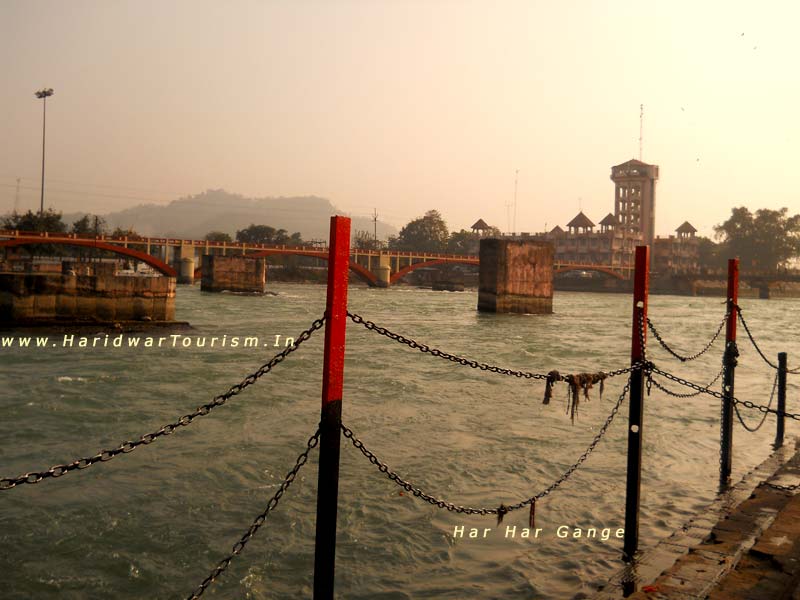
 How to Reach Haridwar - Transport
How to Reach Haridwar - Transport
Haridwar is headquarters of Haridwar district and it has good connectivity
with the other towns of the district and the state.
Road
National Highway 58, between Delhi and Mana Pass passes through Haridwar
connecting it with Ghaziabad, Meerut, Muzzafarnagar, Roorkee and Badrinath
and National Highway 74 originating from Haridwar connects it with Kashipur,
Kichha, Nagina, Pilibhit and Bareilly.
Rail
The Haridwar Railway Station located in Haridwar is under the control
of the Northern Railway zone of the Indian Railways. It has direct links
the major cities of India such as Delhi, Mumbai, Kolkata, Chennai, Indore,
Jaipur, Ahmedabad but it lacks direct connectivity to major cities of
Central India namely Jabalpur, Bhopal, Gwalior and Nagpur.
Air
The nearest domestic airport is Jolly Grant Airport in Dehradun which
is a located 35 km from Haridwar. Indira Gandhi International Airport
in New Delhi is the nearest International Airport.
 Industry
In Haridwar :- Industry
In Haridwar :-
Haridwar is rapidly developing as an important industrial township of
Uttaranchal since the state government agency, SIDCUL (State Infrastructure
& Industrial Development Corporation of Uttranchal Ltd.) set up the Integrated
Industrial Estate in a district attracting many important industrial houses
which are setting up manufacturing facilities in the area.
Haridwar has a thriving industrial area situated at the bypass road, comprising
mainly ancillary units to PSU, BHEL, which was established here in 1964
and currently employs over 8000 people.
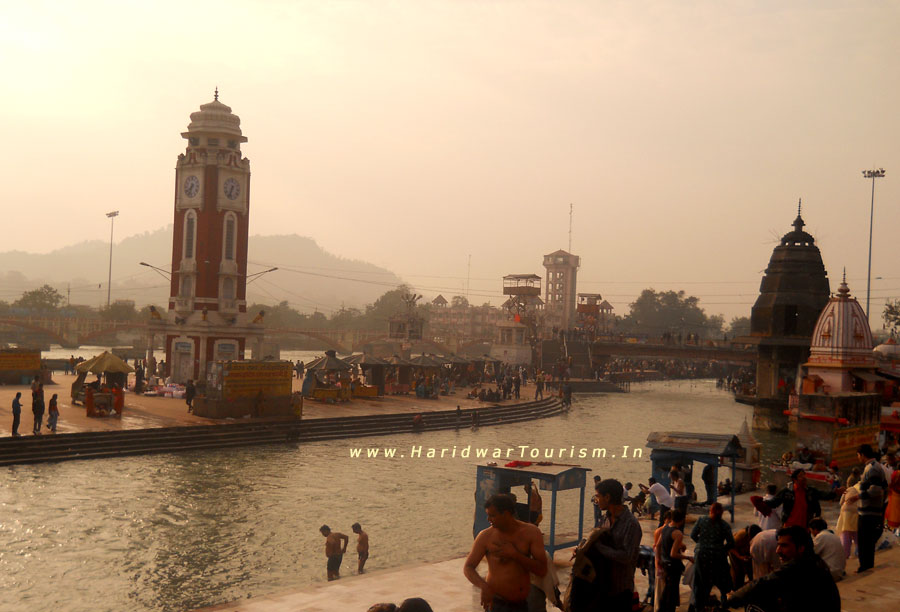
 Climate
- Weather of Haridwar :- Climate
- Weather of Haridwar :-
Haridwar - has a pleasant climate for many months of the year. As its
location is in the hilly terrains, the climate never becomes extreme type.
Thus Haridwar is one such tourist spot that can be visited any time of
the year.
The weather of Haridwar can be studied with a glimpse towards its climatic
conditions. The maximum temperature recorded so far is 27.7 degree Celsius
and the minimum temperature of Haridwar is 14.6 degree Celsius. In the
months of summer the temperature in Haridwar varies from 35 degrees to
45 degrees Celsius. The temperature ranges from 10 degrees to 30 degrees
Celsius in the months of winter. The weather of Haridwar often becomes
unpredictable. There are frequent precipitation that takes place. The
annual mean rainfall in Haridwar is about 2136.7 mm.
The holy city of Haridwar lies at the bank of river Ganga. The region
is surrounded by the Himalayas and falls under the climatic conditions
of the western part of the Himalayas. The day remains pleasant and sunny
with comparatively cold evenings. The winters are very cold and the summer
season is mild and moderate followed by a good rainfall in monsoon.
 Summer
Season in Haridwar :- During the months from March to June. The maximum
temperature that you can expect during the summer is around Summer 20
°C to 40 °C. Summer
Season in Haridwar :- During the months from March to June. The maximum
temperature that you can expect during the summer is around Summer 20
°C to 40 °C.
 Monsoon
Season in Haridwar :- Monsoon season is from July to September and
during this time most activities are suspended due to the heavy blast
of rains. Rainfall is highest in the month of August. During the month
of October and November the conditions are pleasant and temperate. Monsoon
Season in Haridwar :- Monsoon season is from July to September and
during this time most activities are suspended due to the heavy blast
of rains. Rainfall is highest in the month of August. During the month
of October and November the conditions are pleasant and temperate.
 Winter
Season in Haridwar :- Winter season can be cold in the town and the
temperatures can be expected to around 6 °C. The barometer rises up to
a maximum of 16 °C during the winter months. Wollen clothing is essential
during this period. Winter
Season in Haridwar :- Winter season can be cold in the town and the
temperatures can be expected to around 6 °C. The barometer rises up to
a maximum of 16 °C during the winter months. Wollen clothing is essential
during this period.
 Rishikesh to Haridwar
Rishikesh to Haridwar
Rishikesh is located very close to Haridwar at a distance of around 20
Kms so most people choose to visit both places.
Rishikesh to Haridwar both are easily reachable by road and rail. There
is direct train to Rishikesh from Haridwar which is also a convenient
travel option. From Haridwar To Rishikesh Bus Service :- Regular bus services
connect both the places, covering the distance in 20 to 25 mins. Buses
run frequently (at least every half hour) and are very economical. Besides,
hiring taxi is another option to reach Haridwar.
 By Train - Haridwar Railway Station
By Train - Haridwar Railway Station
From Delhi there are many trains to Haridwar, some of the best are :-
Shatabadi Express, Jan Shatabdi, AC Special Express, Mussoorie Express.
to buy a ticket.
Trains from Haridwar
Haridwar - Delhi 07:00
Haridwar - Haridwar 08:10
Haridwar - Bandikui 14:10
Haridwar - Haridwar 14:20
Haridwar - Haridwar 18:35
 Stay safe - Haridwar
Stay safe - Haridwar
Like all Hindu holy towns, Haridwar has more than its fair share of filth,
aggressive beggars and charlatans.
During festivals, especially the Kumbh Mela, Haridwar is packed to bursting
and beyond. Stampedes are a regular occurrence, with over 50 killed in 1986,
21 killed in 2003 and 5 killed in 2010; the bridges across the Ganges are
the most dangerous spot.
 Tour Packages For Haridwar & Rishikesh
Tour Packages For Haridwar & Rishikesh
Rishikesh Tourism provides MORE THAN 20 Packages for Rishikesh
& Haridwar + Pickup & Drop facility from Delhi - Rishikesh - Dehradun
to Haridwar or anywhere in Uttarakhand.
 |
 |
 |
| |
Available All Types of Vehicles at Haridwar
& Delhi

DELUXE BUSES, INNOVA, INDIGO, INDICA, SUMO, QUALIS, TEMPO-TRAVELER,
TAXIS |
|
|
 |
 |
 |
 |
For
Transport Rates - Hotel Booking in Rishikesh
or Rishikesh Tour Packages
Please Call us at  09536-1182-78
or
09536-1182-78
or
 09027-1555-78
(10.30 am - 6 pm)
09027-1555-78
(10.30 am - 6 pm)
Office Landline Number: 05942- 237476 (10.30 am -6 pm)
05942- 237476 (10.30 am -6 pm)

|
|



